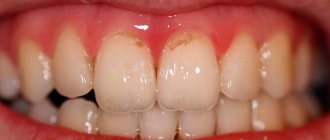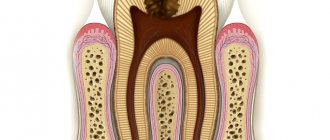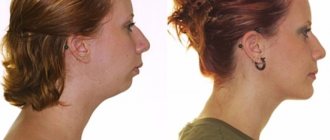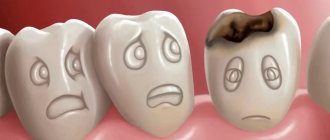Cervical caries, which occurs at or under the gum, is considered one of the most dangerous forms of caries. In the cervical area, tooth enamel is more vulnerable to cariogenic microbes, so pathology develops very quickly. In the article we will consider the features of the course and methods of treatment of cervical caries.
The structure of a tooth, when it comes to its structure, includes three main elements: the root, the neck and the crown. The first two are hidden by soft tissue. The enamel on them is thinner, and there are fewer minerals in it than on the visible part, so it is more vulnerable to cariogenic bacteria. Caries that develops in the area where the tooth comes into contact with the gums and under them is called cervical or root caries. It occurs mainly in adults over 30 years of age, and can appear on both the front and chewing teeth.
In this article
- Why does cervical caries occur?
- Stages of cervical caries
- How is cervical caries diagnosed?
- How to treat initial cervical caries
- How is advanced cervical caries treated?
- How to treat cervical caries on the front teeth
- What you can do at home
The problem with cervical caries is that it is almost asymptomatic until the third stage. The person does not complain of pain or discomfort, there is no visible destruction, and therefore treatment begins late. At the same time, basal caries progresses rapidly. The disease does not pose a serious danger if you visit the dentist every six months. People who rarely visit dental offices are at risk of losing a tooth. Let's talk about the causes and symptoms of cervical caries.
Why does cervical caries occur?
The main cause of any type of caries is damage to the enamel by cariogenic microorganisms from the group of streptococci. They live in the oral cavity of almost all people. Under certain conditions, microbes begin to actively multiply and secrete acids that corrode the enamel, washing away minerals from it. Demineralization of the enamel surface causes exposure of hard tooth tissues. Bacteria penetrate microcracks in dentin and form a carious cavity. Without treatment, it spreads and leads to gradual tooth decay. However, microbes alone are not enough for the development of caries. They are dangerous only in the presence of other factors for the occurrence of carious lesions. Among them:
- Insufficient oral hygiene. If you brush your teeth twice a day, use dental floss and irrigators for cleaning, then the risk of caries is quite low. Otherwise, deposits and food debris will accumulate in the interdental spaces and gum pockets. They are a favorable environment for the spread of microbes.
- Poor nutrition. Cariogenic bacteria feed on carbohydrates. Immediately after eating sweet foods, which contain a lot of fast carbohydrates, active proliferation of microbes begins. This process is accompanied by a sour taste in the mouth. The more sweets a person eats, the more often he develops tooth decay.
- Nicotine addiction. Smoking contributes to the formation of plaque on the enamel. Over time, it mineralizes and hardens, leading to the formation of tartar, which contains many bacteria. They may also be covered with plaque, as a result of which caries begins to develop between the enamel and tartar.
- Disorders of the salivary glands. Saliva not only washes away food debris and microbes from the oral cavity, but also neutralizes the waste products of cariogenic bacteria. Some diseases are accompanied by insufficient saliva production, which can become a factor in the development of caries.
- Enamel abrasion. The enamel surface protects the hard tissues of the tooth from external factors. Some people's enamel is very thin and tends to wear away, resulting in more tooth decay.
These are the main factors in the development of caries. But there are many other reasons, including weak immunity, mechanical injuries to teeth, hormonal imbalances, endocrine pathologies, etc. If they are not eliminated, the disease will periodically recur.
How to prevent caries?
Keeping your natural teeth healthy is quite possible. To do this, you must follow the following recommendations:
- Two or three times a week, carefully examine your teeth in good lighting with your mouth wide open. It is worth paying attention to any changes, including small dots or stripes on the white enamel. These are the areas most vulnerable to tooth decay as they lose fluoride and calcium.
- Brush your teeth regularly using additional hygiene products. This must be done in the morning and evening for 2-3 minutes. Ideally, after every meal. But if this is not possible, it is advisable to at least use a rinse aid. If you use an electric toothbrush, you can remove plaque and food debris more efficiently. After brushing, you should use dental floss to remove any stuck food bits between the units. For the best possible result, you can use an irrigator. The powerful water jet of this device cleans any hard-to-reach areas. This device is especially useful for people with braces, crowns, and dentures.
- Remineralize the enamel. During the procedure, the teeth are saturated with calcium and fluoride, which strengthens the enamel. At home, remineralization can be done using toothpastes containing fluoride and special gels. At the dentist's office, a special fluoride varnish is applied to the teeth. In this case, the active substance penetrates the enamel within several hours, after which the product dissolves. By regularly saturating the enamel with fluoride, your teeth will remain healthy.
- Remove any plaque and tartar in a timely manner. If this cannot be done during daily oral hygiene, you must contact your dentist for professional teeth cleaning and removal of stones using ultrasound.
- Limit the amount of sweet and starchy foods in your diet. Increase your consumption of foods rich in calcium and vitamin D, phosphorus and fluorine, as well as solid vegetables and fruits.
- Strengthen immunity. This is facilitated by taking vitamins and minerals, hardening, proper balanced nutrition and a healthy lifestyle. When the immune defense is good, the body can resist bacterial attack.
There is also such a caries prevention measure as fissure sealing. In short, the essence of the procedure is to apply a protective coating to the chewing surfaces of the teeth. This manipulation is often performed on children, but an adult patient can also receive this service.
Stages of cervical caries
Cervical caries develops according to the same scenario as other types of this disease, but much faster. Let us describe the stages of development of root caries:
- Initial (white spot stage). It is asymptomatic. A demineralized area of enamel forms in or under the gum area. It looks like a white or chalky spot. Gradually it begins to fade, but this is difficult to notice with the naked eye, especially if the pathology is localized on the back surface of the tooth or on the molars and premolars. If it starts under the gum, then it can only be detected using hardware diagnostics.
- Superficial. The carious spot becomes larger and acquires a yellowish or brownish tint. Destructive processes begin on the tooth surface. At this stage, the pathological focus has not yet spread to hard tissue. The patient may experience discomfort when eating sweet foods. It disappears immediately after the stimulus is removed. Often people attribute this symptom to increased sensitivity of the gums.
- Average. Damage to hard tissues is observed. A person experiences severe discomfort when eating sweet, sour, cold or hot foods. Possible pain. These signs disappear as soon as you brush your teeth.
- Deep. The last stage is an advanced form of the disease. Deep damage to dentin occurs. The pathological process involves the tooth root and pulp. The tooth may split into several parts or break in the neck area. The patient almost constantly experiences pain, which painkillers do not help eliminate.
Treatment for caries can vary depending on the degree of damage to the tooth. The method is selected individually after diagnosis.
How do you know if a decayed tooth needs to be removed?
Unfortunately, there are often cases when a tooth is so damaged that classical treatment methods in the form of filling are simply impossible. If the root of the tooth is preserved and can be used as a basis for installing a crown, the dentist can make a verdict about preserving the root. However, in some cases, root removal is necessary.
It is carried out if:
- as a result of periodontitis in the final stages, significant tooth mobility became noticeable,
- damage to the tooth root causes significant pain, discomfort and swelling,
- deep damage reaches the level of soft tissue and cannot be restored,
- a cyst has formed that cannot be eliminated without removing the root,
- part of the tooth wall has broken off, and the second goes under the gum,
- wisdom teeth cause frequent severe pain and interfere with the normal development of other teeth,
- After the tooth was removed, part of the root remained in the gum.
How is cervical caries diagnosed?
If the carious lesion is localized on the visible part of the tooth, the doctor makes a diagnosis after an external examination. But to confirm it, a special test is performed using a dye solution. It is applied to the enamel and left for 3-4 minutes. The affected area turns blue. After a few hours, the dye is completely washed out of the mouth.
The doctor may also prescribe an x-ray to assess the nature of the spread of caries, the depth of the carious cavity, the condition of the nerve endings, etc. Based on the results of the examination, a treatment method is selected. It is determined, first of all, by the stage of the disease.
How to treat initial cervical caries
At the white spot stage, caries can be treated using therapeutic procedures. It is necessary to restore the enamel structure by saturating it with minerals. First, the dentist will clean the affected tooth from plaque and tartar, and then apply a solution containing fluoride, magnesium, phosphorus and calcium to it. Under the influence of the active components, the enamel is remineralized and the pathological process is blocked. The patient is also prescribed mouth rinses with an antiseptic solution and toothpaste with fluoride.
How to treat superficial caries
If the carious area has managed to destroy the enamel, but has not penetrated into the hard tissues, remineralization is carried out, as in the first stage. The dentist grinds the affected area of the tooth, removes damaged tissue and applies a solution to the enamel to restore it. Several procedures may be required - 5-10 sessions. Throughout the treatment, the patient uses medicated toothpaste.
Treatment of cervical caries at the middle stage
As a rule, people consult a doctor when root caries has reached the third stage. At this stage, tooth filling is required. The doctor removes the affected tissue, carries out antiseptic treatment of the carious cavity and fills it with filling material. The procedure is performed under local anesthesia.
Main symptoms and stages of the disease
There are several symptoms, the appearance of which should alert each of us. If they are detected, do not delay your visit to the dental clinic. The most common symptom of the onset of an irreversible process in tooth tissue is the accumulation of a large amount of yellow plaque and stone on the enamel.
It is also abnormal to have a strong and very unpleasant odor from the mouth, even with constant use of rinses and breath fresheners. Dark spots may appear on the enamel, and the teeth themselves may react sharply to exposure to hot or, conversely, very cold food or drinks.
If the above symptoms are ignored, dark spots may appear on the enamel, particularly near the neck of the tooth and even on the roots. The patient may complain of frequent pain, which is not relieved even by strong painkillers and radiates to the temples and the back of the head. Subsequently, the process of pulp death begins, the disease affects the nerve endings located inside the tooth, as a result of which the pain becomes simply unbearable and has a constant, aching character.
How is advanced cervical caries treated?
Deep caries is often accompanied by damage to the pulp, so depulpation is required. After this, root canal treatment and filling are performed. In some cases, nerve removal can be avoided. Then treatment is carried out according to the standard algorithm:
- Anesthesia.
- Removal of deposits and tartar.
- Selecting the shade of the future filling.
- Retraction of the gingival margin.
- Preparation of a carious cavity.
- Tooth isolation.
- Grinding.
- Filling.
- Polishing the filling.
The procedure can be more complicated if the carious lesion is located under the gum. It has to be cut to open access to the neck and root. After the main treatment, the doctor applies sutures, which dissolve within a few days.
If the patient goes to the doctor late and the tooth is almost completely destroyed, it is removed. The question arises about installing an implant.
Treatment or tooth root extraction
If the root of a tooth is more than 50% caries-covered, it is usually removed. Further treatment is aimed at eliminating the inflammatory process and preventing infection of neighboring tissues. In some cases, it is possible to save a tooth by restoring the root with an artificial onlay.
Dental root caries spreads through hard tissues quite quickly. Gradually, the process of destruction covers the gums and spreads to neighboring teeth. There is a risk of damage to the jaw bone. For this reason, doctors recommend coming for an examination every six months in order to detect pathology in time. At the initial stage it is treated with medication, at the next stage - surgically.
How to treat cervical caries on the front teeth
Cervical caries of the anterior teeth causes the most discomfort. Firstly, it develops and progresses faster than on molars and premolars. Secondly, the front teeth fall into the smile zone, so a cosmetic defect also occurs. Treatment is carried out according to the usual scheme, but the material for the filling is selected more carefully. It should not differ in color from the rest of the tooth, otherwise it will look unaesthetic. The cost of such a filling is significantly higher than the standard one.
What you can do at home
We described the features of caries treatment at different stages in the dentist's office. Many people are interested in the question of what to do if the disease develops at home, whether it can be stopped on their own. The only thing available to the patient is prevention. If a carious lesion has already begun, it is impossible to reverse it with the help of rinses or folk remedies.
However, you can slow it down or stop it if you follow a number of simple rules:
- brush your teeth twice a day and rinse your mouth after eating;
- give up sweet foods and sodas;
- quit bad habits, in particular smoking;
- use irrigators to clean the oral cavity.
In addition, do not forget to check your teeth every six months, even if you are not worried about caries symptoms.










